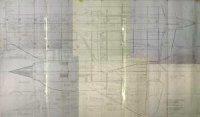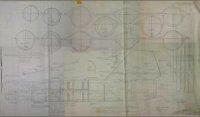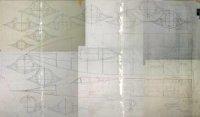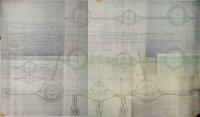



I started the construction on this airplane in June 1990. It has gone between my
apartment and three homes as I have gotten married and been transfered from Ohio to Nevada
to Maryland. The plans call for .40 size ducted-fan units to be buried halfway
through the ducts in the nacelles. I realized that .40's would be too weak to power
this plane at 1/12 scale, or 108 inches long. Below are small samples of the plans from
which I built my aircraft. David Ross at Ross Hobbies owns the rights to the plans and now
manufacturers a kit based on these plans. Please see David's website at http://www.rosshobbies.com/ for more info on this
and other kits. If you can't contact David, please see this
page.
|
|
|
|
I also decided that I could not afford ducted fan units, so I built it originally to take two OS .61 FSR's with 11x7 props on the front of the nacelles. I even got to the point of having the engines installed and running, with the airframe covered with black Monokote. Hint: Never install large sheets of black Monokote - it looks horrible. The seems do not blend together like most Monokote colors. I didn't like the way it turned out and hung up the airframe until we moved to Nevada.
One year for Christmas I received two OS .65 VR-DF's and Turbax III fan units. My endless begging paid off! Finally I could give this plane what it deserved as a power source. I removed all the Monokote (except on the rudders) and gutted the nacelles. The nacelles were hollowed and 1/16 inch balsa was added as ducting. I did not bury the engines in the middle of ducts as the plans called. This would have placed the CG too far back. The front of each nacelle was extended to the correct scale location to hold the fan units, and the two 16 ounce fuel tanks were moved to the main body.
I swapped my Hirobo Shuttle ZXX carbon fiber helicopter for two complete sets of OS 91 VR-DF's with Dynamax fans and tuned pipes. The Dynamax fans and OS 91 engines dropped ringht into the Blackbird with very few modifications. The tuned pipes did require quite a bit of ducting change, but now the plane has almost 22 pounds of static thrust.
The rudder connections required a bit of thought to keep the controls
internal while allowing for the ducting, but I succeeded in making no-slop connections
that are completely enclosed. The servo sits in the wing, on the inboard side of
each nacelle. Push-pull cables run from the servo around the inside of the nacelle
to a control horn attached to the rudder torque rod. The drawings for these rudder
connections is shown below.
|
Airframe Components:
(2) OS .91 VR-DF ducted fan engines, (2) Dynamax fan units, (2) 16 oz tanks
Rhom-Air retracts, double wheels on each strut
two elevators: 2 servos each (4 total) - each elevator controlled separately
two ailerons: 2 servos each (4 total) - each aileron controlled separately
two rudders: 1 servo each (2 total)
nose steering: 1 servo - rudder and nose steering controlled together
retract valve: 1 servo
throttle: 1 servo
JR 8103 computer radio, dual 1200 mah battery packs
Please take a look below for shots of the plane through all stages of
construction. These are thumbnails, so click on each picture to see a bigger
version.
| Initial frame-up of the 1/4" lite-ply bulkheads in 1990. Spruce 1/4" x 1/2" hardwood is the support. | |
| Same stage as above. | |
| 1/4" thich balsa sheeting has been added to the body and nacelles. Rhom-Air retracts have also been installed. All air connections and servo leads go to the cockpit. | |
| Same stage as above. | |
| Same stage as above. | |
| All balsa sheeting has been added to the top surface of the airframe. | |
| Same stage as above. | |
| Engine pods, engine mounts, and fuel tanks have been added for OS .61 FSR engines. At this stage, ducted fan power was considered too expensive, and I had no experience with ducted fans. | |
| Same stage as above. | |
| Nacelles have been hollowed, all construction is done. Awaiting fiberglass. | |
| Same stage as above. | |
| Same stage as above. | |
| Blackbird and my Klingberg Wing x 2 next to each other for comparison. | |
| Fiberglass and painting done. Construction complete. | |
| Same stage as above. | |
| Same stage as above. | |
| Me and my Blackbird. | |
| Markings have been added and the entire airframe has been painted with several coats of gloss clear. | |
| Same stage as above. | |
| Camera bay markings added to bottom. | |
| Camera bays. | |
| Same stage as above. | |
| Same stage as above. | |
| The cockpit is closer to the single seat A-12 interceptor version, but please ignore that (along with the marking inaccuracies). | |
| Still shot from the taxi test video below. | |
| Still shot from the taxi test video below. | |
| Still shot from the taxi test video below. |
Take a look at the picture above of the Blackbird and wing together. The SR-71 is 9 feet long and the wing has a span of 11 feet. The wing weighs 11 pounds complete and has almost 20 square feet of surface area. That gives a wing loading of about 9 oz/ft^2. The Blackbird weighs 23 pounds at this stage and has about 14 square feet of surface area. The final complete weight will be 30 pounds, which gives a wing loading of about 34 oz/ft^2.
Nine years of hangar rash, complete remodeling, and two cross-country moves have made this airplane a labor of love and obsession. It is finally nearing completion. All construction has been completed. Will it fly? Stay tuned for updates. The video below was made during a taxi test when the Blackbird had OS 65 engines. The plane now has OS 91 engines.

Update, September 2006: Flight was attempted during September 2006,
but my club's paved runway is only 150 feet long. The plane would begin to rotate
but could not get off the ground before running into the grass off the other end.
Several attempt were made with extra pushes and run-ups before the pavement.
It made a lot of noise and the nose came up, but did not quite fly. I need a
longer runway. Here is shot of my youngest son on the left with some friends before
the attempt.